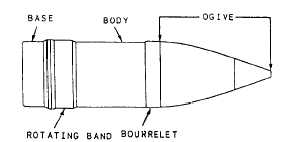| |
designations of bore diameter, such as 20-mm, 3-inch,
or 5-inch, the length of the gun bore in calibers is also
used as a means of classification. Thus a 3-inch,
50-caliber projectile is one used in a gun having a bore
diameter of 3 inches and a bore length of 50 times 3
inches, or 150 inches. The three types of ammunition
classified by assembly are shown in figure 6-1.
Fixed Ammunition
The Fixed class of ammunition applies to
ammunition that has the cartridge case crimped around
the base of the projectile. The primer is assembled in the
cartridge case. The projectile and the cartridge case,
containing the primer and propellant charge, form one
unit as a fixed round of ammunition. Small-caliber guns
and guns through 3-inch, 50-caliber use fixed
ammunition.
Semi-fixed Ammunition
Semi-fixed, or separated ammunition, applies to
ammunition that consists of two units: the projectile
assembly and cartridge case assembly. The projectile
assembly consists of the projectile body containing the
load, the nose fuze, the base fuze, and the auxiliary
detonating fuze, as applicable. The cartridge case
assembly consists of the cartridge case, primer,
propellant charge, wad, distance piece, and a plug to
close the open end of the cartridge case. Semi-fixed
ammunition is produced in gun sizes of 5-inch,
54-caliber through 8-inch, 55-caliber guns.
PROJECTILES
The projectile is that component of ammunition
that, when fired from a gun, carries out the tactical
purpose of the weapon. While some types of projectiles
are one piece, the majority of naval gun projectiles are
assemblies of several components. All of the projectiles
briefly discussed by classification in this chapter have
several common features, as described in the following
paragraphs and as illustrated in figure 6-2.
Ogive
The ogive is the curved forward portion of a
projectile. The curve is determined by a complex
formula designed to give maximum range and accuracy.
The shape of the ogive is generally expressed by stating
its radius in terms of calibers. It may be a combination
of several arcs of different radii.
Bourrelet
The bourrelet is a smooth, machined area that acts
as a bearing surface for the projectile during its travel
through the bore of the gun. Some projectiles have only
one bourrelet (forward); the rotating band serves as the
bearing surface in the rear. Other projectiles have one
bourrelet forward and one or two aft, the after one being
located adjacent to and either forward or aft of the
rotating band. Bourrelets are painted to prevent rusting.
Body
The body is the main part of the projectile and
contains the greatest mass of metal. It is made slightly
smaller in diameter than the bourrelet and is given only
a machine finish.
Figure 6-1.–Types of gun ammunition: fixed (top); semi-fixed
(center); and separate-loading (bagged gun) (bottom).
Figure 6-2.–Typical projectile, external view.
6-3
|





